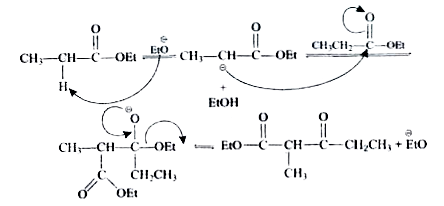Find out number of reactions which involve electron deficient
nitrogen during reaction mechanism.
CH3−O∣∣C−ClNaN3−−−−−→H2O
The correct Answer is:4
To solve the question, we need to analyze the reaction of the acid chloride with sodium azide (NaN₃) and identify the steps that involve electron-deficient nitrogen.
1. Identify the Reactants:
The reactants in this reaction are an acid chloride (in this case, CH₃C(=O)Cl) and sodium azide (NaN₃).
2. Understand the Structure of Sodium Azide:
Sodium azide consists of the azide ion (N₃⁻), which has a linear structure: N⁺≡N⁻—N⁻. The terminal nitrogen atoms (N⁻) are electron-rich, while the central nitrogen (N⁺) is electron-deficient.
3. Reaction Mechanism:
When the acid chloride reacts with sodium azide, the nucleophilic azide ion attacks the carbonyl carbon of the acid chloride. The mechanism involves the following steps:
- The electron-rich nitrogen (N⁻) from the azide attacks the electrophilic carbon of the acid chloride.
- This leads to the formation of a tetrahedral intermediate, which then collapses, expelling chloride ion (Cl⁻) and forming an azide compound.
4. Formation of Electron-Deficient Nitrogen:
In the process, the nitrogen that was part of the azide ion becomes involved in the formation of the new bond with the carbon atom of the acid chloride. The central nitrogen (N⁺) in the azide ion is electron-deficient and plays a crucial role in this reaction.
5. Count the Reactions Involving Electron-Deficient Nitrogen:
- The initial attack of the azide ion involves the electron-deficient nitrogen.
- The rearrangement that occurs after the formation of the tetrahedral intermediate also involves this nitrogen.
- Therefore, we can conclude that there are at least two significant steps in the reaction mechanism that involve the electron-deficient nitrogen.
Conclusion:
The number of reactions that involve electron-deficient nitrogen during the reaction mechanism is 2.
---
The reactants in this reaction are an acid chloride (in this case, CH₃C(=O)Cl) and sodium azide (NaN₃).
Sodium azide consists of the azide ion (N₃⁻), which has a linear structure: N⁺≡N⁻—N⁻. The terminal nitrogen atoms (N⁻) are electron-rich, while the central nitrogen (N⁺) is electron-deficient.
When the acid chloride reacts with sodium azide, the nucleophilic azide ion attacks the carbonyl carbon of the acid chloride. The mechanism involves the following steps:
- The electron-rich nitrogen (N⁻) from the azide attacks the electrophilic carbon of the acid chloride.
- This leads to the formation of a tetrahedral intermediate, which then collapses, expelling chloride ion (Cl⁻) and forming an azide compound.
In the process, the nitrogen that was part of the azide ion becomes involved in the formation of the new bond with the carbon atom of the acid chloride. The central nitrogen (N⁺) in the azide ion is electron-deficient and plays a crucial role in this reaction.
- The initial attack of the azide ion involves the electron-deficient nitrogen.
- The rearrangement that occurs after the formation of the tetrahedral intermediate also involves this nitrogen.
- Therefore, we can conclude that there are at least two significant steps in the reaction mechanism that involve the electron-deficient nitrogen.
The number of reactions that involve electron-deficient nitrogen during the reaction mechanism is 2.
Similar Questions
Knowledge Check
- Question 1 - Select One
Which is the major product of the following reaction ?
CH3−O∣∣C−ClH2S−−→productACH3−OH∣C∣SH−ClBCH3−O∣∣C−SHCCH3−S∣∣C−ClDCH3−O∣∣C−S−O∣∣C−CH3 - Question 2 - Select One
Arrange the compounds in order of decreasing reactivity for nucleophilic addition reaction
CH3−O∣∣CI−CH2−Cl Cl−CH2II−O∣∣C−H H−O∣∣CIII−H H3C−O∣∣CIV−CH3AI>Iv>II>IIIBI>II>III>IVCII>III>I>IVDII>I>III>IV - Question 3 - Select One
When two molecules of an ester undergo a condensation reaction, the reaction is called a Claisen condensation. The product of a claisen condensation is β ketoester.
2CH3CH2−O∣∣C−OEt1.CH3CH2ϴO−−−−−−−−−−→2.H⊕CH3CH2−O∣∣C−C∣CH3H−O∣∣C−OEt+EtOH
Mechanism:

Find out product of following reaction:
 APh−CH2−O∣∣C−CH2−PhBPh−CH2−O∣∣C−CH∣Ph−O∣∣C−OEtCPh−CH2−O∣∣C−CH∣Ph−O∣∣C−OHDNone of these
APh−CH2−O∣∣C−CH2−PhBPh−CH2−O∣∣C−CH∣Ph−O∣∣C−OEtCPh−CH2−O∣∣C−CH∣Ph−O∣∣C−OHDNone of these
Find out number of reactions which involve electron deficient
nitrogen during reaction mechanism.
Ph−O∣∣C−OHN3H,DiluteH2SO4−−−−−−−−−−−→View SolutionThe major product formed in the reaction
CH3CH=CH−O∣∣C−CH3NaBH4−−−−−−−−→H2O,CH3OH isView SolutionFind out number of products obtained by cross Cannizzaro's reaction between
a. H−O∣∣C−H+Ph−O∣∣C−HNaOH−−−−−−→H2O
b. Ph−O∣∣C−H+(CH3)3C−O∣∣C−HKOH−−−−−→H2OView SolutionComplete the following reactions:
PhCHO+CH3NO2ΘOH−−→Δ(A)View SolutionWrite the IUPAC name of the following compound CH3−CH2−O∣∣C−C∣CH3H−Cl
View Solution

